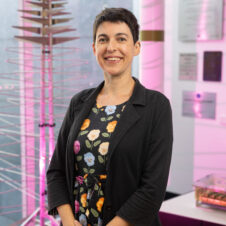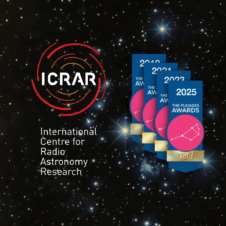The Earth’s changing climate is a critical issue for us all. At ICRAR, we believe every profession has a responsibility to examine work-related emissions. That’s why we’re taking positive action to measure and reduce the carbon footprint of our research activities.
What is ICRAR doing to assess its carbon emissions?
We audited the carbon emissions of our research activities in a study to be published in Nature Astronomy in September 2020. The study found that the work-based emissions of an average astronomer are 40 per cent higher than the average Australian non-dependant (across work + life emissions), and five times the global average.
The most significant contributor to ICRAR’s carbon footprint (amounting to an estimated 22 tonnes of carbon dioxide per year per astronomer) was our reliance on supercomputing facilities to create cosmological simulations and process the enormous volumes of data that the telescopes we use gather from the sky.
Next, was air travel undertaken by astronomers travelling to observatories, attending meetings with collaborators or attending conferences. This amounted to an estimated 6 tonnes of carbon dioxide per year per astronomer before the COVID-19 pandemic.
What is ICRAR doing to reduce its carbon emissions?
Supercomputing
Most of ICRAR’s supercomputing requirements are currently met by ANU’s National Computational Infrastructure; the Pawsey Supercomputing Centre; and the OzSTAR supercomputer, operated by the Swinburne University of Technology.
Significant steps have already been taken to reduce emissions relating to supercomputing.
- ICRAR researchers are required to design algorithms in a way that processes their data as efficiently as possible.
- The Pawsey Supercomputing Centre uses geothermal heat exchange to cool its supercomputers and limit their carbon footprint.
- As of July this year, Swinburne’s OzSTAR supercomputer is powered entirely by procured renewable energy.
Recently, ICRAR also began working with DownUnder GeoSolutions (DUG)—an innovative Perth-based company with four data centres around the world. DUG’s supercomputers are suspended in vats of synthetic oil, reducing overall power consumption by more than a third compared to traditional air-cooled supercomputing operations.
Earlier this year, DUG processed 450 hours of data from the Murchison Widefield Array, a precursor to the Square Kilometre Array radio telescope. DUG’s team worked closely with ICRAR/Curtin researcher Associate Professor Cathryn Trott to optimise the code and ensure efficient use of the supercomputers. Find out more about this work here.
Air Travel
Our astronomers are part of an international community that regularly travels to operate the world’s ground and space-based telescopes and meet with collaborators.

ICRAR PhD Candidate Hosein Hashemizadeh in the remote observing control room setting up for observing with the Anglo-Australian Telescope.
In recent years, more and more observatories have developed the capability to be remotely controlled from anywhere in the world, reducing the need for astronomers to travel.
A remote observing control room has been established at ICRAR to take advantage of this and reduce the costs and environmental impact of our astronomers travelling to international locations to operate telescopes.
Before COVID-19, there was already a growing push for meetings and conferences to be hosted virtually, to reduce the need for in-person attendance. The pandemic has accelerated this shift, and the experiences garnered from this period will undoubtedly impact how the need to travel is assessed in the decades to come.
ICRAR’s Sustainability Officers
These individuals will contribute to the Astronomical Society of Australia’s Sustainability Working Group (see below); identify opportunities for how the Centre can reduce its carbon footprint; and make recommendations to our executive team that will shape the organisation’s policies and procedures going forwards.
Decadal plan for Australian astronomy 2016-2025
Published in 2015, this document presents the strategic vision for Australian astronomy for the next decade. In July of 2020, the Australian Academy of Science released a mid-term review of the plan.
DECADAL PLAN FOR AUSTRALIAN ASTRONOMY 2016-2025: MID-TERM REVIEW
This document states that during the mid-term consultations with researchers located around the country, much concern was expressed about
astronomy’s collective carbon footprint. Subsequently, the following recommendations were made to guide the Australian astronomical community on this issue.
- Reduce air travel by increased use of virtual and remote conferencing capabilities and the creation of an improved remote participation experience.
- Use carbon-neutral options for conference and workshop catering and resourcing.
- Install and enable wider use of remote observing facilities.
- Build future facilities with remote observing, automated observing, or robotic capabilities as standard.
- Concentrate HPC usage on energy-efficient and low-carbon solutions, and invest effort, such as through ADACS services, in improving software efficiency.
ASA’s Sustainability Working Group
In response to the mid-term review, the Astronomical Society of Australia (ASA)—the professional body representing astronomers in Australia—recently established a Sustainability Working Group. This group will develop:
- An optimal set of trackable indicators for institutes to determine progress made towards sustainability.
- Best practices for the astronomy community and facilities in the form of a sustainability action plan.



